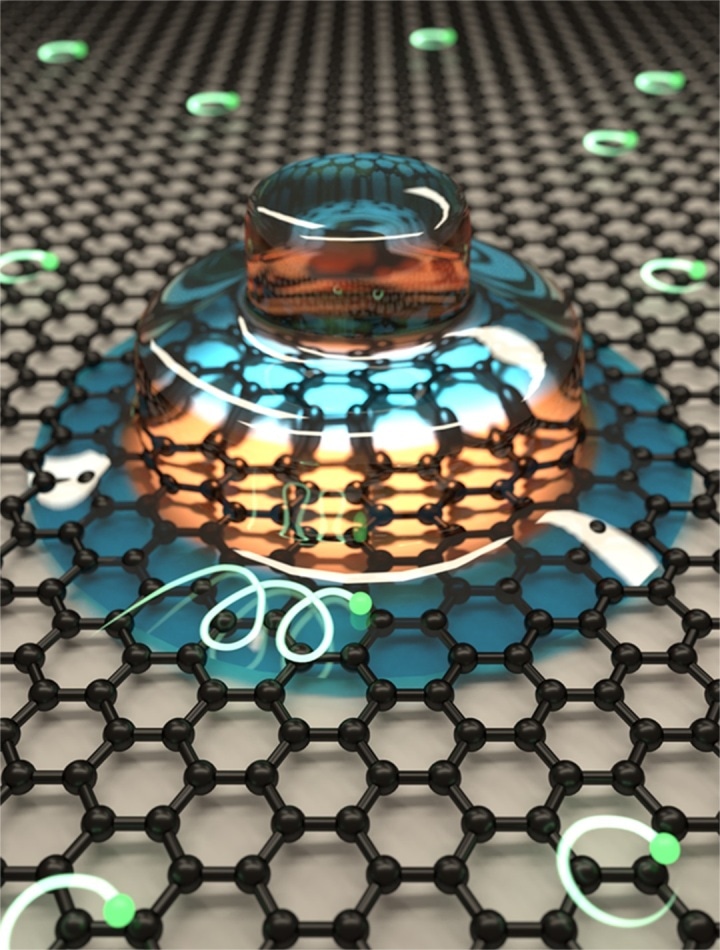Nov 13 2018
In an alliance between quantum science and solid-state physics, scientists from the National Institute of Standards and Technology (NIST) have employed magnetic fields to restrict groups of electrons to a sequence of concentric rings within graphene, a single layer of tightly packed carbon atoms.
 Illustration of the wedding cake structure formed by electrons magnetically confined within tiny regions in graphene. (Image credit: C. Gutiérrez/NIST)
Illustration of the wedding cake structure formed by electrons magnetically confined within tiny regions in graphene. (Image credit: C. Gutiérrez/NIST)
Such a tiered “wedding cake,” which is depicted in images illustrating the energy level structure of the electrons, experimentally establishes the way electrons interact in a highly restricted space based on long-untested quantum mechanical rules. The outcomes of the study could also find practical applications in quantum computing.
Due to its exceptional ability to conduct electricity, mechanical strength, and ultrathin, typically 2D structure, graphene is a very propitious material for innovative electronic devices. Hence, any new insights into this wonder material are highly appreciated by researchers.
The scientists, who have reported the outcomes of their study in the August 24 issue of Science, started their experiment by developing quantum dots—tiny islands that function as artificial atoms—in graphene devices cooled to only a few degrees above absolute zero.
Electrons orbit quantum dots in a manner that’s highly analogous to the way they orbit atoms. Similar to rungs on a ladder, they have the ability to occupy only particular energy levels based on the rules of quantum theory. However, a unique thing happened when the scientists applied a magnetic field, which further restricted the electrons that orbit the quantum dot. When the strength of the applied field reached about 1 Tesla (nearly 100 times the typical strength of a small bar magnet), the electrons packed closer than ever and interacted more vigorously.
Consequently, the electrons rearranged themselves into an innovative pattern—an alternating sequence of insulating and conducting concentric rings on the surface. Upon stacking the images of the concentric rings that were recorded at different electron energy levels, the ensuing picture looked like a wedding cake, where the vertical dimension was electron energy.
The structure was revealed by a scanning tunneling microscope, which images surfaces with atomic-scale resolution by recording the electron flow between various regions of the sample and the ultrasharp tip of the microscope’s stylus.
This is a textbook example of a problem - determining what the combined effect of spatial and magnetic confinement of electrons looks like - that you solve on paper when you’re first exposed to quantum mechanics, but that no one’s actually seen before. The key is that graphene is a truly two-dimensional material with an exposed sea of electrons at the surface,” he added. “In previous experiments using other materials, quantum dots were buried at material interfaces so no one had been able to look inside them and see how the energy levels change when a magnetic field was applied.
Joseph Stroscio, NIST scientist and co-author
Suggestions have been made to use graphene quantum dots as basic components of certain quantum computers.
“Since we see this behavior begin at moderate fields of just about 1 Tesla, it means that these electron-electron interactions will have to be carefully accounted for when considering certain types of graphene quantum dots for quantum computation,” stated study co-author Christopher Gutiérrez, now at the University of British Columbia in Vancouver, who carried out the experimental study at NIST with co-authors Fereshte Ghahari and Daniel Walkup of NIST and the University of Maryland.
This accomplishment also opens the door for graphene to function as “relativistic quantum simulator,” as proposed by the scientists. The theory of relativity delineates the way objects act while moving at or close to the speed of light. Moreover, electrons in graphene have a peculiar property—they move as though they are massless, similar to light particles. Despite the fact that electrons in graphene originally travel considerably slower compared to the speed of light, their light-like massless behavior has led them to be called as “relativistic” matter. The innovative research paves the way for developing a table-top experiment to analyze highly restricted relativistic matter.
The Massachusetts Institute of Technology, Harvard University, the University of Maryland NanoCenter, and the National Institute for Material Science in Ibaraki, Japan were the collaborators on this study.
The measurements indicate that researchers might soon discover even more peculiar structures synthesized by the interactions of electrons restricted to solid-state materials at low temperatures.